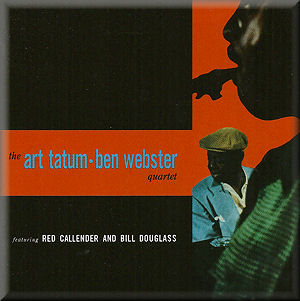1. All the Things You Are
2. Gone with the Wind
3. Have You Met Miss Jones?
4. Night and Day
5. Where or When
6. My Ideal
7. My One and Only Love
8. Gone with the Wind
9. Have You Met Miss Jones?
10. Gone with the Wind
11. My Funny Valentine
12. You're Mine, You!
13. Sophisticated Lady
14. Love's Away
15. All the Things You Are
Art Tatum - Piano (tracks 1-10. 15)
Ben Webster - Tenor sax (tracks 1-14)
Red Callender - Bass (tracks 1-10)
Bill Douglass - Drums (tracks 1-10)
Teddy Wilson - Piano (tracks 11-14)
Ray Brown - Bass (tracks 11-14)
Jo Jones - Drums (tracks 11-14)
I suspect that Adolphe Sax had little idea of the consequences when he invented saxophones: a family of instruments that were used by various classical composers but which became essential in jazz. Could Adolphe Sax have foreseen the use his instruments would find in the hands of Frankie Trumbauer, Sidney Bechet, Coleman Hawkins, Johnny Hodges, Lester Young, Charlie Parker, Gerry Mulligan and John Coltrane? And could he have realised how iconic the tenor saxophone would become in jazz?
One can praise various exponents of the tenor sax but one saxist I would include in the top rank is Ben Webster, who developed his sound from the propulsive growl he gave it with the Duke Ellington Orchestra to the uniquely breathy style of his later years. Among pianists, one of the finest is universally agreed to have been Art Tatum, so it must have been magical when the two men recorded together. And that is certainly the case with this classic album from 11 September 1956.
That genius of producers, Norman Granz, put Tatum and Webster together with the steady but unobtrusive bass and drums of Red Callender and Bill Douglass to record music which is as close to perfection as any jazz I know. Art Tatum could be a difficult accompanist for horn players, as the wealth of notes he played could almost swamp other musicians. Yet here Tatum laid down a cushion for Webster to rest his smooth tone upon. Both men stayed close to the wonderful melodies they chose to play, which included items by Cole Porter and Rodgers & Hart, as well as lesser-known numbers ideally suited to the duettists' sensitivity.
Ben Webster said "I just went into the studio and we played". Two musical giants like these could play with complete relaxation, and that relaxation is evident throughout the session. You only have to hear Art Tatum's introduction to All the Things You Are to feel confident that this album will be a masterpiece. Art keeps close to the melody while decorating it appropriately, and the mood is intensified when Ben enters with smooth restraint. Tatum's accompaniment is as good as an orchestra: full but not excessive. Tatum and Webster fuse together perfectly, with neither trying to outdo the other.
Most tunes are taken at a relaxed mid-tempo. The only fast number is Night and Day which maintains its romanticism despite the increased speed, which is still not excessive. Here and elsewhere, Tatum doesn't merely accompany Webster but he plays a continuous extemporisation beneath Ben - in other words, the two men are improvising simultaneously, creating a rich mixture of melody.
The album's original seven tracks are augmented by an alternative take of Have You Met Miss Jones? and two alternates of Gone with the Wind (possibly the finest track on the album). There are also four cuts from a 1954 session with Ben Webster accompanied by Teddy Wilson, plus a 1953 solo version of All the Things You Are played by Art Tatum (which is more ornate and free than the 1956 version). Teddy Wilson is naturally not as florid as Art Tatum but his backing for Webster is elegantly discreet. As a result, Webster is slightly more extrovert than in the session with Tatum, although there is less of the glorious interplay between two musicians.
The original album was the last studio session ever recorded by Art Tatum, as he died shortly afterwards - on 5 November 1956. Yet no recordings can be better suited as Art Tatum's memorial than these superb tracks.
Tony Augarde
www.augardebooks.co.uk
